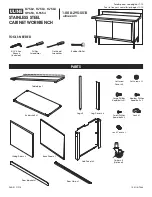
Roth DWT Installation Manual
9
Lubricating & Hydraulic Oil Storage and Dispensing
Section 3 - Pre-Installation
It is very important to read and familiarize yourself with these instructions before
installing the tank(s). There are a number of steps that are crucial to a successful
installation and to maintaining the warranty.
Permits and Approvals
Installing a single Roth EcoDWT plus 3 inside a building is a straightforward process.
Nearly all municipalities have codes governing the installation and use of oil tanks.
Always consult with the code officers and inspectors before installing a Roth EcoDWT
plus 3 to be sure you are in compliance with all applicable local codes and have
obtained all required permits. Code officers may be unfamiliar with the Roth double wall
tank, so time taken in acquainting the officer(s) with the tank’s unique advantages and
certifications will usually make final approval much easier.
Warnings and Cautions
To the Wholesaler:
1. Fully inspect the tank for shipping damage. The tanks are inspected for damage before
shipment from the manufacturing facility and must be inspected for shipping damage upon
delivery. If damage is found, the shipping company, not Roth Industries, must be notified.
2. Do not remove shrink wrap covering unless it will be replaced with similar material.
3. Do not store tanks outside without shrink wrap covering to prevent water seepage into the
interstitial space between the two tanks and to prevent the destruction or loss of the supplied
warranty materials.
4. Tanks should not be stored outside or uncovered for more than thirty (30) days to prevent
UV degradation of plastic materials
5.
Confirm that the warranty package is with the tank. It is located on top of the tank under the
shrink wrap and easily visible. If it is missing contact Roth for a replacement package.
To the Installer:
1. Do not remove the shrink wrap until the tank has either been moved inside or is ready to
have the cover placed on it if an outside installation.
2. Failure to follow the instructions given in this installation manual may:
a. Void the tank warranty.
b. Compromise the structural integrity of the tank, requiring its replacement.
c. Result in personal injury and/or property damage.
d. Make the installer liable to penalties under applicable state and local law.
4. Do not install without obtaining appropriate permits and approvals.










































